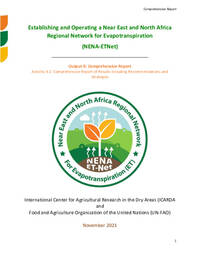Output 9: Comprehensive Report Activity 9.2: Comprehensive Report of Results including Recommendations and Strategies

Authors:
Actual Evapotranspiration (ETa) is the main component required to understand both hydrological and
ecological processes between the land surface and the atmosphere. Reliable spatiotemporal
measurements of ET are important for water resources planning, management and monitoring, efficient
irrigation scheduling, and climate change mitigation scenarios development. Virtually no existing
coordinated measurements and initiatives to validate various estimates of ETa are systematically carried
out in the NENA Region although the region is extremely water scarce and vulnerable to climate change.
Therefore, the Water Scarcity Initiative (WSI) of FAO for the Near East and North Africa, conceived and
promoted the coordination of ETa field measurements as vital in the region with a consistent protocol
established through this ET-Network project, which could effectively be used to validate and calibrate the
remotely sensed estimations. The overarching objective of this project (named NENA-ETNet) was to
establish and operate a NENA Regional Network of specialized institutions, within the countries of
reference, to conduct field measurements of actual ET, over selected crops and for at least four seasons,
in order to evaluate the accuracy of existing RS-based ET estimates. The idea was to build a common
regional understanding on ETa measurements (ETa) in the field and through RS, on accuracy assessments
of RS ETa data of different databases and on their analyses and use for agriculture-related applications
(e.g., water accounting, water productivity, water management, etc.). Therefore, ICARDA was called upon,
in collaboration with FAO and five countries in the region, to establish such a regional ET network to obtain
reliable source of ground measurements of ET with the multiple goals of calibrating and validating RSbased
ETa retrievals, calibrating and validating crop models and to do regional synthesis using the
measured data in a multi-location, multi-season manner, in the context of regional water scarcity. The
NENA-ETNet had a special focus on comparing CORDOVA-ET system using other field ETa methods of
determination in order to decide if CORDOVA-ET method could be used as a regional standardized
validation protocol. The participating countries were Egypt, Jordan, Lebanon, Morocco and Tunisia. The
participating countries now have good capacity and facilities for ET measurements using energy balance
and micro-meteorological methodologies, lysimeter and gravimetric methods. This report briefly
summarizes all the project research results, learnings, challenges, recommendations and strategies on the
way forward.
